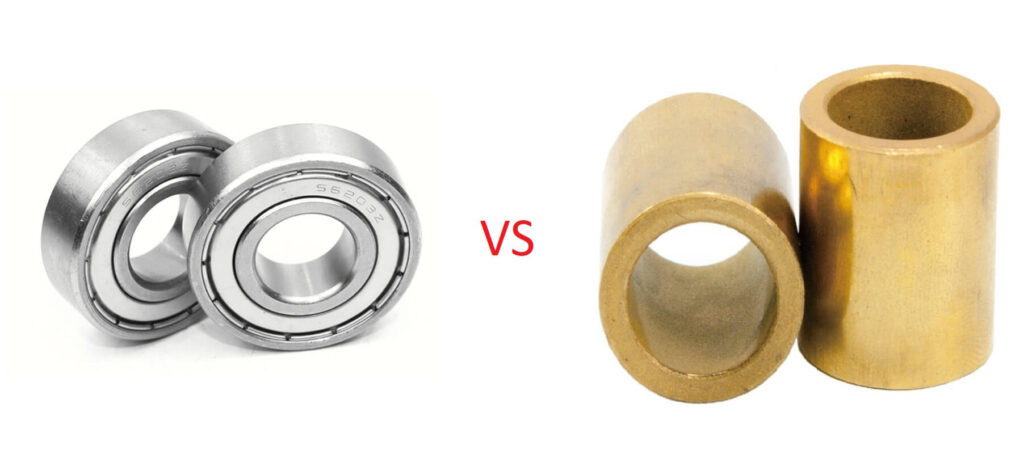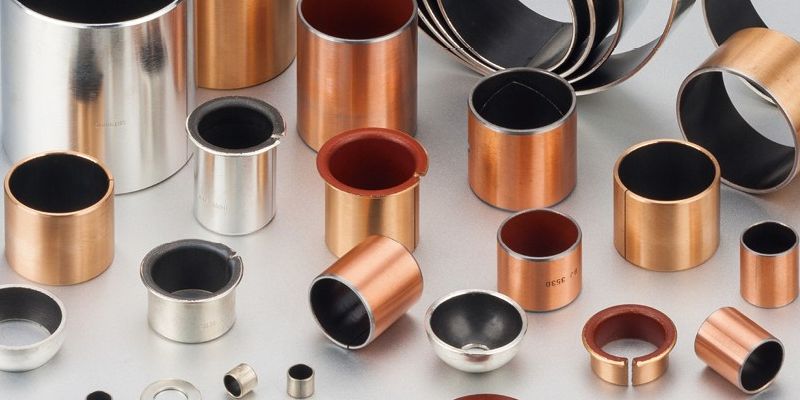Last Updated on October 18, 2024 by Chen

Bushings and bearings are both used to reduce friction in moving parts, but they differ in design and application. Bushings, also called sleeve bearings, are cylindrical components that support sliding motion between two surfaces. They’re simpler, often made of a single material, and excel in high-load, low-speed applications. On the other hand, bearings typically consist of two rings with rolling elements (like balls or rollers) between them, supporting rotating motion. They’re more complex, better suited for high-speed, precision applications, and often provide both radial and axial load support.
Bushing vs. Bearings: The Major Difference
Bushing vs. Bearing is a crucial topic in mechanical engineering and machine design. We use various components in our machinery to reduce friction and facilitate smooth operation. For instance, in automobiles, industrial equipment, and home appliances. These machines incorporate different elements that serve unique purposes.
Similarly, bushings and bearings are two devices that exist in larger mechanical systems. Here, a bushing is a component that is employed to support loads on sliding-motion shafts operating between two surfaces. On the other hand, a bearing is a device that is used to support rotating motion shafts while providing a form of location between them.
There are different types of bushings, such as bronze bushings; they offer excellent wear resistance and are ideal for high-load applications. Moreover, plastic bushings provide low friction and can operate without lubrication, etc. On the other hand, bearings come in various forms like ball bearings and roller bearings. They play their role in reducing friction and ensuring smooth rotation of one surface relative to another.
Bushings are classified by their material (like metal, polymer, or composite) and shape (cylindrical, flanged, etc.), while bearings are divided by their rolling elements (balls, rollers) and load direction (radial, thrust, or both). A component that slides over shafts or rods to create low-friction movement is introduced as a bushing, and a component that uses rolling elements between two rings to facilitate smooth rotation is designated as a bearing.
What is a Bushing?
Bushing – commonly referred to as sleeve bearings, is a cylindrical element built to support loading on an operational shaft that glides back and forth between the moving surfaces. A bushing is a single-element component that may be constructed from a variety of materials. Bushings slide over rods or shafts to provide a motion with extremely low friction, excellent shock absorption, and a reduction in energy use, noise, and wear.
What Are the Types of Bushings?
There are numerous bushing types with various material compositions available on the market. Some are great at controlling high pressure and impact, while others can withstand corrosion. You can select the ideal bushing type based on the application and operating circumstances for your industrial or manufactories purposes.
Bushings can be classified based on two major elements; material and shape. By material, the bushing has three common types including composite bushing, metallic bushing, and plastic bushing. The bushing has four other types based on shape including cylindrical plain bushing, flanged bushing, thrust washer, and sliding plates.
Bushing Types by Material
1. Polymer or Composite Bushings
Polymer bushings, aka composite bushings, are better at carrying heavy loads. These are the most commonly used bushings as they offer low friction and wear-resistant features. Polymer or composite bushing reduces equipment breakage caused by improperly greased component components.
In addition, polymer or composite bushings are used to convey rotational motion when at least one of two rubbing components in a machine or micro mechanism is constructed of polymer. Polymer or composite bushings can be used in settings where conventional bearings would be in danger.
These bushings can be used in a range of industries including construction equipment, hydraulic systems, medical devices, aerospace, and more.
The composite bushing is further classified into two major types as mentioned below:
POM Composite Bushing
POM bushings are mainly used to reduce vibration and noise in your machines. Since composite bushings are often made from a durable material, it makes them the ideal choice for reducing wear on bearings. POM composite also helps reduce heat buildup that is caused by friction. This helps in extending bearing life up to four times longer than other conventional materials such as steel.
PTFE Composite Bushing
This is the kind of bushing that has been made using two different materials including Teflon and metal. These types of bushings are used as bearings in various industrial applications. The core purpose is to reduce friction between moving parts in a machine.
2. Metallic Bushing
As the name states, these bushings are made of metal or metal alloys making up a two to three-layer structure that has steel backing. These bushings have very high mechanical strength, making them suitable for high-speed and load applications where lubrication is involved. The metals used depend upon the type of industrial setting or application. These bushings have different lubrication methods depending upon their size, make-up, and application.
The metallic bushing is further classified into 6 major types including:
Bronze Bushing
Bronze is a preferred material for bushings as is usually found in a variety of alloys and compositions. You can use bronze bushing for various purposes in industrial manufacturing.
Bronze bushings are more resistant to deformation and fracture than other materials. Like plastic, bronze bearings are strong and rust-resistant. Self-lubricating bronze bushings are also available in the market that you can use in various applications.
You can use bronze bushings in various ways and for numerous applications including food processing, injection molding, automotive machines, earthmoving machinery, iron and steel manufacturing, and more.
Graphite Bushing
Graphite bushings are employed in many applications as they offer unique mechanical and physical properties. Graphite bushings assist the efficiency, productivity, and performance of spinning machinery because of their low coefficient of friction.
Graphite, a naturally oily mineral, is the best material for bushings because it reduces friction without the use of additional fluids. Bronze bushings with graphite plugs are used to create graphite lubrication bearings. Graphite has the highest temperature stability retaining its shape and structure at temperatures up to 5000°F.
Machined graphite is widely utilized in hot settings such as in load capacity systems where metals lubricants and grease deteriorate. You can use graphite bushing for countless purposes including furnaces and ovens, food applications, chemical industries, automotive industries, metals, and more.
Steel Bushing
As the term implies, steel bushings are made of steel or stainless steel. These bushings are made with highly durable steel making them the perfect tool for low-speed pivot applications. Steel bushings are made using an eco-friendly production method that improved material yield and reduce chips.
บูชทองเหลือง
Brass bushing aka brass sleeve bushing is typically made of brass. The brass bushing is a component of the pivot that helps protect the body from any damage that may be caused by any forces transferred through the shaft.
You can use brass bushing for a range of purposes including electric motors, car engines, and more. Moreover, brass bushing comes in a range of sizes as they can fit thin and thick walls, flanged, cylindrical, flanged, and more.
Aluminum Bushing
Aluminum bushings are preferred for their hardness which ensures a long life span. Originally, it was used in bicycles but made its way up to be used in automobiles and presently, in a variety of different machines.
Aluminum Bushings can withstand great axial and radial loads, making them a worthy candidate to be used aerospace and agriculture industry as well. Some of their more common applications include their use in hydraulic cylinders for mounting instruments (e.g. drain plugs/fluid fill, fluid sight glasses, or breather elements), containers, and tanks.
Bi-Metal Bushing
As the name suggests, bi-metal bushings are made of two different metals. In particular, it involves two metal strips of different metals; in most cases, the first metal is steel whereas the other matter may vary from copper to aluminum and even brass. This bimetal layer acts as an internal covering for the bushing, providing good protection against wear. They are particularly useful in applications where medium loads are operated at medium speeds or high loads with slow speeds.
3. Plastic Bushings
Plastic bushings are an excellent alternative to metal bushings in a lot of applications due to their low wear rate. They are lightweight in comparison to metal bushings and have lower coefficients of friction. Since they are made of plastic, they can easily conform under load and retain their ability to perform at their optimum capacity. Made of composite plastics, they have high tensile strength and serve in various industrial applications.
Plastic bushings mainly consist of thermoplastic alloys and solid lubricants. They also have a fiber matrix that enforces the strength of their structure. They are comparatively more affordable as they are made of low-cost materials like polyethylene, nylon, Teflon, and UHMW. High-end plastics such as Torlon, PEEK, and Vespel make up an expensive range of plastic bushings.
Plastic bushing comes in further four types as mentioned below:
บูชไนลอน
Nylon bushings are rugged and are increasingly replacing metal bushings in a lot of applications. The material has outstanding wear properties along with eliminating the need for external lubrication.
Nylon bushings, despite being tough are lightweight and do not make as much noise as metal bushings when operating. They have a low coefficient of friction and high resistance against weak acids, fuels, and alkalis.
Polymer Bushing
Self-lubricating and needing zero maintenance, polymer bushings are made of woven structure that guarantees high tensile strength and easily outclasses injection mold bushings. They have high resistance to heavy loads and galling, making them suitable for applications involving oscillation and high speeds.
Polymer bushings are mostly chemically inert; they have a low water absorption rate and can work at high temperatures with no deformation.
PTFE Bushing
PTFE bushings are low friction and have the capability to withstand high-temperature swings, making them suitable for a number of industrial applications. They are categorized as multifunctional bushings as they can be used in a variety of industries ranging from electrical, thermal, nuclear, chemical, pharmaceutical, and even power plants. They are commonly found in trains and high-performance machines.
They are made of materials that display high tolerance for environmental factors, heat resistance, low coefficient of friction, and non-adhesive properties. The only downside is that they are highly flexible, which means they can often crawl or twist. By adding fillers, this too can be fixed and allows the manufacturers to offer a highly versatile bushing.
POM Bushing
Developed with self-lubrication in mind, these bushings are suitable for heavy loads operating at low speeds. They have good wear resistance with a low coefficient of friction. Applications of POM bushings can be found in industries like agriculture, civil, mechanical, and construction.
Polyoxymethylene bushings or POM bushings are usually made from steel backing with a sintered copper/bronze layer applied to it. Finally, a POM layer is added to the copper/bronze layer that incorporates grease pits that retain the lubricants.
Bushing Types by Shape
In terms of shapes, there are four main types of bushings.
Cylindrical Plain Bushing
Just as the name suggests, cylindrical bushings are cylindrical in the shape, made in industry-standardized dimensions that are machine parts made ready to fit. Cylindrical bushings have a backing both, on the inside and outside that supports the sliding layer in the middle.
Cylindrical bushings are stronger than bearings and able to withstand higher forces than metal bearings, making them ideal for unidirectional variable loads, pivoting movements, and axial guide bearings.
Flanged Bushing
Flanged bushings are almost identical to cylindrical bushings with one distinct difference, they have a flange on one end. The flange can serve a number of purposes ranging from mounting or alignment of the bushing to a convenient installation. They are commonly used in through-bolt applications enabling the use of a smaller diameter bolt to save weight without resulting in a decrease in the fastener’s bearing surface against the Spar wall, while also decreasing stress from the mounting bolt thread.
เครื่องซักผ้าแรงขับ
Thrust washers are not bushings themselves, but a very vital component. They are basically flat washers that are located between a stationary component and a rolling surface, supporting axial load or motion on a shaft going side-to-side, restricting any movement along the shaft. They make up a surface on top of which a bearing or a bushing is supported.
Sliding Plates
Sliding plates are common components used for tooling and mold making. They are low maintenance and popular in industries like automotive, mechanical engineering, lifting, welding technology, injection mold machines, and conveyor technology.
Sliding plates are considered linear bearings that may be extension joints of bridges or other mechanical components. The principal is pretty similar to that of a bearing or bushing. Where one plate is stationary and the other slides over it to counter expansion or contraction. Sliding plates can be made of a variety of materials ranging from steel to PTFE, and TEF-MET.
What is a Bearing?
A bearing is a machine element that lowers friction and handling stress while enabling machinery to run at high speeds. It is often made up of two multiple elements. You can use bearings in various industrial applications to support machinery rotating shafts. Bearings provide some sort of position between machine parts while allowing smooth movement between them.
Bearings allow the two interrelating surfaces to slide, roll, or slither over one another rather than grinding against one another by distributing the load to the rolling parts and allowing the machine to spin.
What Are the Types of Bearings?
The following are the most common types of bearing that are used in industrial applications depending on the nature of the required relative movement and the restrictions that must be placed on it.
1. Ball Bearing
Ball bearings are the most common and frequently used type of bearings. Ball bearing is a mechanical component that enhances the efficiency of systems and equipment.
The rolling element of the ball bearing is a single row of rolling balls. The rolling balls are positioned between two rings. These balls are generally made of stainless steel to reduce friction.
You can use ball bearings for various industrial purposes from little grocery carts to enormous machinery and power plant installations. Ball bearings reduce friction between moving parts or surfaces with the help of the rolling components, resulting in extremely accurate outcomes.
2. แบริ่งธรรมดา
The most typical type of bearing is a plain bearing, commonly referred to as a ‘slide bearing’ or a ‘sliding bearing’. Plain bearings are among the most widely utilized and inexpensive types of bearings for various purposes.
Plain bearings typically have three separate movements, and each motion gives the bearing a distinct name.
- For both radial and rotational motions, the bearing is termed a journal bearing.
- For linear movement, the bearing is titled a linear bearing or slide bearing.
- For axial movements or those that arise on an axis, the bearing is titled a thrust bearing.
However, the most common plain bearing type is referred to as ‘journal bearing’. You can use journal bearing for countless applications including camshafts, crankshafts, combustion engines, power trains, rotating applications, and more.
3. Roller Bearing
Since both ball bearings and roller bearings are made to carry weight without creating friction, they are relatively similar to one another. However, a roller bearing is one with a rolling element. These bearings can have one or more rows of rolling components and are extremely adaptable to use for any application.
A roller bearing transfers larger loads than a ball bearing even though it prevents the separation of its moving components by using cylindrical rollers rather than balls. The roller bearings have two rows of rolling elements.
When combined with various roller shapes, roller bearings may withstand radial and axial loads by minimizing friction. Roller bearings are typically suitable for low-speed applications, despite the fact that they may be able to support greater weights than ball bearings.
There are many different types of roller bearings available on the market, and each type has a particular application. You can use these roller bearings in cargo systems, engines, the agricultural sector, the aerospace and automotive industry, heavy-duty equipment, medical equipment, power plants, and more.
How to Choose Between Bearings and Bushings?
Choosing between the best bearing or bushing types is dependent on the type of industrial application along with the requirements of machines. This includes fundamental factors like:
• Speed
• Load capacity
• Stress
• Productivity
• Machine efficiency
• Smoothness of the operation
• Machine velocity
• Operational noise
• Machine durability
• And design of the machine components
If your applications are relative to sliding in contrast to rolling, then opting for Bushing is your best option. Other applications where choosing bushing is your best option include vehicle suspension systems, movement of precision machine parts, and balancing applications.
If your applications are relative to a contract between components where they interact inside a machine, choosing bearings is your best option. For applications that are high velocity and low-load with a high degree of precision, then choosing bearings is the best course of action.
It is best to consult with an expert before opting for either bearing or bushing as some applications may make it seem that they are interchangeable. Please note that bearings and bushings cannot be substituted for one another, which is why knowing which one to choose is very important.
When a Bushing Should Be Used Instead of A Bearing?
Bearings are used in a wide sphere of applications, but there are some applications where bushings are a far better option than bearings. If your application requires high load-bearing tolerance, you should opt for bushing instead of a standard bearing. If your application requires constant lubrication, you need to opt for an option that eliminates that problem for you. Bushings are self-lubricating because they have a uniform pattern of indents on their surface that act as lubricant reservoirs. Moreover, if there are applications that require dry operations without the use of lubricants, then bushings are also ideal since nylon bushings can operate without lubricants.
In short, the main parameters to determine when you should use bushings instead of bearings are:
• Load capacity
• Speed of operation
• Lubrication
• Nature of application (maintenance-free applications require bushings)
Talk to A Bushing Manufacturing Expert
Choosing between bushing or bearing can be tricky, which is why it is best to talk to an expert. At บูช MFG, we have a team of experts who are readily available to cater to the requirements of our valued clients. Understanding a wide range of industrial applications, we have been manufacturing self-lubricating bushings since 2006, making us experts in our industry. Exporting our quality goods to South America and Europe for 12 ปี, we offer a one-stop solution for retailers, manufacturers, and distributors.
Get In Touch Now!


